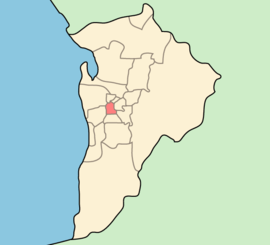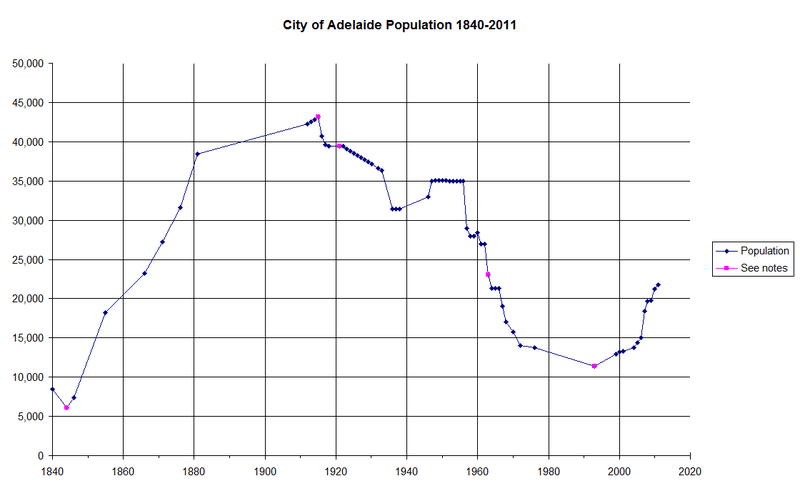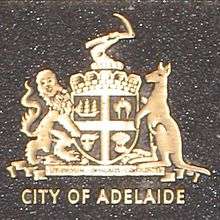City of Adelaide
| City of Adelaide South Australia | |||||||||||||
|---|---|---|---|---|---|---|---|---|---|---|---|---|---|
 | |||||||||||||
| Population | 22,393 (2015)[1] | ||||||||||||
| • Density | 1,438.2/km2 (3,725.0/sq mi) | ||||||||||||
| Established | 1840 | ||||||||||||
| Area | 15.57 km2 (6.0 sq mi) | ||||||||||||
| Mayor | Martin Haese | ||||||||||||
| Council seat | Adelaide city centre | ||||||||||||
| Region | Metropolitan Adelaide | ||||||||||||
| State electorate(s) | Electoral district of Adelaide | ||||||||||||
| Federal Division(s) | Division of Adelaide | ||||||||||||
 | |||||||||||||
| Website | City of Adelaide | ||||||||||||
| |||||||||||||
The City of Adelaide is a local government area in the metropolitan area of Adelaide, South Australia. It covers the original Adelaide city centre settlement, (also known as the city, the square mile and (inaccurately) the CBD), North Adelaide, and the Adelaide Park Lands which surround North Adelaide and the city centre.
Established in 1840, the organisation now known as the Adelaide City Council (ACC) is the oldest municipal authority in Australia. At its time of establishment, Adelaide's (and Australia's) first mayor, James Hurtle Fisher, was elected. From 1919 onwards, the municipality has had a Lord Mayor, the current being Martin Haese who replaced Stephen Yarwood in 2014.
History
Initially the new colony was managed by the colonial government. The first municipality was established in 1840 as the Adelaide Corporation. However, due to a combination of the hostility of the incoming Governor Grey and falling revenues due to the onset of the colony's first economic crisis, the corporation became moribud in 1843. From 1843 to 1849, control and management reverted to the colonial government, and from 1849 to 1852 the municipality was managed by a Commission with five members. With the positive economic effects of the Victorian gold-rush, a formal municipality was re-established in 1852, and "has operated continuously ever since".[2][3][4][5][6] However, The city's relationship with the state and federal government has been described as being 'a continually abrasive relationship'.[7]
The Council started in 1840 with nineteen members, who chose four of their number to be Aldermen, and then one of these (James Hurtle Fisher) to be Mayor. In 1852 the municipality was divided into four wards. Three Councillors and one Alderman were chosen, who in turn selected the Mayor. In 1861 the Mayor was chosen by all the electors and the position of Alderman was temporarily abolished. In 1873 the municipality was divided into six Wards, each represented by two Councillors. In 1880 the office of Alderman was recreated; they were chosen by electors of all Wards. The office of Mayor was raised to the stature of Lord Mayor by Royal Letters Patent in 1919. The Lord Mayor received the right to be styled ‘The Right Honourable’ in 1927.[4][6]
The Arms of the City of Adelaide were granted by the Heralds College in 1929.[3] In 1982 the Council approved the design of the Armorial Flag.[3]
In 2015, the Council became the first government of any kind in Australia to offer a financial incentive for installing battery systems.[8]
Population
At the end of the 20th century, the city had little more than thirty per cent of the population it had in 1915 (when the population reached more than 43,000), and about 5,000 less than the 1855 population of 18,259.[6] According to the Annual Reports since then,[9] the population has increased rapidly, and in line with the targets stated in the strategic plans developed at about that time.


- Notes
- The population figures have been extracted from Adelaide City Council Annual reports. The data is summarised on pages 149-150 of A Thematic History.[10] Additional data not in that summary can be found in the reports on the council's "Annual Reports" page.[9]
- 1840 The initial Annual Report noted a population of 8,480, with 1,615 buildings in the city.
- 1844 The second available figure (6,107) is also the minimum recorded in council reports.
- 1880s There are no figures available for the period between 1881 and 1912. South Australia suffered a severe depression in the 1880s when the State population, (and probably the city's population too), declined.
- 1915 The peak population was 43,133.
- 1921 The State population passes 500,000. The city population was 39,458.
- 1963 The State population passes 1,000,000. The city population was 23,000.
- 1993 There is only one figure available between 1976 and 1999 - 11,405 in 1993. It was in the late 1990s that the council developed and started implementing its plans to increase the city's population, and not until 2004 when it started regularly updating the population estimates based on figures supplied by the Bureau of Census and Statistics.
- 2001 In 2001, the council set targets for population numbers for 2006 and 2010. These targets were raised considerably in 2003. In 2009, targets were set for 2012.
| Year | 2010-11 | 2009-10 | 2008-09 | 2007-08 | 2006-07 | 2005-06 | 2004-05 | 2003-04 | 2002-03 | 2001-02 | 2000-01 | 2006 goal | 2010 goal | 2012 goal | |
|---|---|---|---|---|---|---|---|---|---|---|---|---|---|---|---|
| Permanent residents |
21,800 | 21,200 | 19,800 | 19,700 | 18,400 | 15,000 | 14,361 | 13,734 | 13,289 | 25,000 | 34,000 | 25,500 | |||
| Dwellings | 13,100 | 12,500 | 11,388 | 10,600 | 9,900 | 9,900 | 9,600 | 7,335 | 7,335 | 5,510 | |||||
| Overnight population |
29,800 | 29,200 | 27,400 | 27,100 | 23,800 | 22,000 | 21,090 | 19,610 | 17,861 | 17,861 | 19,900 | 34,500 | |||
| Overnight visitors |
8,000 | 8,000 | 7,600 | 7,400 | 5,400 | 7,000 | 6,729 | 5,866 | |||||||
| Daily visitors(*) |
86,500 | 79,000 | 74,000 | 60,000 | 75,000 | 75,000 | 75,000 | 103,500 | 103,500 | 125,000 | 150,000 | ||||
| Workers | 126,500 | 126,500 | 118,500 | 108,000 | 108,000 | 99,000 | 95,682 | 93,000 | 93,000 | 89,000 | 98,000 | 111,000 | 125,000 | ||
| Students | 90,000 | 88,000 | 86,700 | 81,100 | 75,000 | 63,000 | 59,240 | 51,900 | 50,597 | 50,000 | 58,000 | 66,000 | |||
| Daily population |
220,000 | 205,000 | 208,200 | 190,000 | 200,000 | 200,000 | 216,000 | 215,000 | |||||||
| Office space(**) |
1.503 | 1.443 | 1.200 | 1.184 | 1.038 | 1.100 | 1.109 |
* Visitors to the city from the Adelaide Metropolitan area, for all purposes
** Square kilometers (millions of square metres) of office space. i.e. 1.503 km2. = 1,503,000 sq. metres. The total area of the City of Adelaide is 15.6 km2., of which 7.6 km2. is Park Lands.
Sources:
2010-11
2009-10
2008-09
2007-08
2006-07
2005-06
2004-05
2003-04
2002-03
2001-02
2000-01
1999-00
1998-99
1997-98
Services and amenities
Apart from providing the usual services like rubbish collection and controlling local development, the City of Adelaide owns and operates a number of city services and amenities, including:
- A network of 11 car parking stations (Central Market, Grote, Gawler, Grenfell, Pirie/Flinders, Light Square, Rundle, Topham, Sturt, Wyatt and Frome) branded as U-Park.
- Adelaide Central Market, a popular tourist attraction and working market selling cheap fruit and vegetables and other products.
- Adelaide Aquatic Centre, offering several indoor heated swimming pools, diving facilities, and a health club.
- A network of four local library and community centres from which local residents can borrow books, music, videos and computer programs, and gain access to computers and the internet.
- Free bus services, 98C and 98A,(operated as The Connector until 2014), which runs through the CBD and North Adelaide, with stops at every major tourist attraction and council library. A new Connector bus, with more seating capacity, entered service in 2007, replacing one of the smaller buses that used to ply the route. The bus is named Tindo (after the Kaurna word for sun) and is hailed as the world's first solar powered bus.[11] The 98C is a clockwise loop while the 98A is anti-clockwise and the service has now been modified to better suit everyone's needs.[12]
Sister cities
The City of Adelaide currently has international partnership arrangements with: [13]
 Christchurch, New Zealand since 1972
Christchurch, New Zealand since 1972  George Town, Penang, Malaysia since 1973
George Town, Penang, Malaysia since 1973 Himeji, Hyogo, Japan since 1982
Himeji, Hyogo, Japan since 1982 Austin, Texas, USA since 1983
Austin, Texas, USA since 1983  Dalian, Liaoning, China since 2001
Dalian, Liaoning, China since 2001  Chengdu, Sichuan, China since 2001
Chengdu, Sichuan, China since 2001 Qingdao, Shandong, China since 2013
Qingdao, Shandong, China since 2013
Flag
The armorial flag of Adelaide, was approved on August 2, 1982.[14]
Notable residents
- William Bragg – Nobel Laureate of Physics - X-ray crystallography as a method for 3-D structure determination of inorganic salts[15]
- Howard Florey – Nobel Laureate of Medicine - Widespread development and application of penicillin[16]
- Robin Warren – Nobel Laureate of Medicine - Discovered role of Helicobacter pylori in gastric ulcers[17]
- Shaun Micallef – Actor and host of Talking About Your Generation
- Frank Woodley – Actor and comedian
- Paul McDermott – Host of Good News Week
- Sir Donald Bradman - Now deceased ( Died in 2001 ) Reference : https://www.google.co.in/search?q=Don+Bradman+&ie=utf-8&oe=utf-8&client=firefox-b&gfe_rd=cr&ei=fYemV8-fFoLC8gfo7ozwAg
- Julia Gillard - 27th Prime Minister of Australia
See also
- List of Adelaide suburbs
- List of Adelaide parks and gardens
- Local government areas of South Australia
References
- McDougall & Vines (2006) The City of Adelaide - A Thematic History, www.adelaidecitycouncil.com. (PDF, 780Kb, 156 pages)
- Peter Morton (1996) After Light: A History of the City of Adelaide and its Council, 1878-1928
- ↑ Australian Bureau of Statistics (30 March 2010). "Regional Population Growth, Australia, 2008–09". Archived from the original on 5 June 2010. Retrieved 4 June 2010.
- ↑ home page, City of Adelaide website
- 1 2 3 History, City of Adelaide
- 1 2 Lord Mayors & Mayors, City of Adelaide
- ↑ Books mentioned on the City of Adelaide history webpages: Those Turbulent Years. A History of the City of Adelaide 1929–1979, Pubs, pews and powerbrokers, The City of Adelaide - A Thematic History
- 1 2 3 A Thematic History, pp81-82.
- ↑ Morton, After Light p. 10
- The city's relationship with the state and federal government has been described as being 'a continually abrasive relationship'. Until 1877 the relationship with the colonial government was described as 'a grudging tolerance, breaking out occasionally into active resentment whenever the council felt its rights were being infringed'. Moreover, matters such as alienation of the Park Lands by the state government, and threats to do so by the federal government, together with the fact that the federal and state government were exempt from rates for the many city buildings they owned, did nothing to enhance the relationship between them and the city corporation.
- ↑ Sophie Vorrath (23 June 2015). "Adelaide City Council offers energy storage incentive, Australia's first". Renew Economy. Retrieved 7 July 2015.
- 1 2 Annual Reports, Adelaide City Council.
The page contains links to all Annual Reports since 1997-1998. - ↑ A Thematic History, pp149-150.
- ↑ "All-Electric, Solar-Powered, Free Bus!!!". Ecogeek.org. 27 December 2007. Archived from the original on 8 September 2009. Retrieved 2013-01-12.
- ↑ "New free City connector bus service". Adelaide City Council. Retrieved 16 October 2015.
- ↑ Sister Cities - Adelaide City Council Retrieved 10 October 2013
- ↑ History of Council - The Armorial Flag, City of Adelaide website
- ↑ "The Nobel Prize in Physics 1915: William Bragg, Lawrence Bragg". Retrieved 2011-09-12.
- ↑ "The Nobel Prize in Physiology or Medicine 1945: Sir Alexander Fleming, Ernst B. Chain, Sir Howard Florey". Retrieved 2011-09-12.
- ↑ "The Nobel Prize in Physiology or Medicine 2005: Barry J. Marshall, J. Robin Warren". Retrieved 2011-09-12.
External links
- City of Adelaide website
- City of Adelaide community profile
- City Profile and Population (Numbers from 2008-2009 Annual Report)
-
 Media related to Adelaide at Wikimedia Commons
Media related to Adelaide at Wikimedia Commons
Coordinates: 34°56′S 138°36′E / 34.933°S 138.600°E